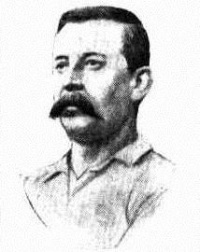William Henry ('Burly') Wright
From The Orange Wiki
WRIGHT, William Henry (‘Burly’)
Service no: 5914 [1]
Place of birth: Lewis Ponds, via Orange, 10 October 1871
Address: 16 Sampson Street, Orange
Occupation: Bridge carpenter
Next of kin: Mary Wright (wife), 16 Sampson Street, Orange
Date of enlistment: 29 May 1916
Place of enlistment: Sydney
Age at enlistment: 42
Fate: Embarked Ceramic Sydney 7 October 1916. Disembarked Plymouth 21 November 1916. Proceeded to France 13 December 1916. Hospitalised France 4 May 1917. Rejoined battalion 24 May 1917. Wounded in action, Belgium 6 November 1917. Died of wounds, 10th Casualty Clearing Station, Belgium.
Date of death: 7 November 1917
Buried: Lijssenthoek Military Cemetery, West-Vlaanderen, Belgium, Plot 22, Row G, Grave 4
William Henry Wright was born in Lewis Ponds in 1871, one of 17 children. ‘Burly’ as he became known was an avid sportsman. A keen footballer, he played for the state against Queensland in 1898, and 1901 to 1904. He also played against New Zealand in 1903 and England in 1904. He was also a fine cricketer and an excellent rifle shot.
William married Mary Pluis in 1898. The couple settled in Sampson Street in Orange and had three daughters, Gladys, Connie and Olga.
‘Burly’ was 46 when he enlisted in May 1916. The Leader reports that when he enlisted he said to wife: "I will go and have one more game of football with the Germans, then come home and settle down for good.”
Unfortunately, this was not to be. On 6 November 1917 ‘Burly’ was wounded in action in Belgium, suffering a shrapnel wound and compound fracture to the left leg. He died of his wounds the following day. He is buried in Lijssenthoek Military Cemetery in West-Vlaanderen, Belgium.
William Wright is commemorated on the Holy Trinity Church Orange Honour Roll and on the World War I Roll of Honour on the southern face of the Orange Cenotaph.
Leader, 27 March 1918, p. 6.
“Burly” Wright’s Last Game [2]


